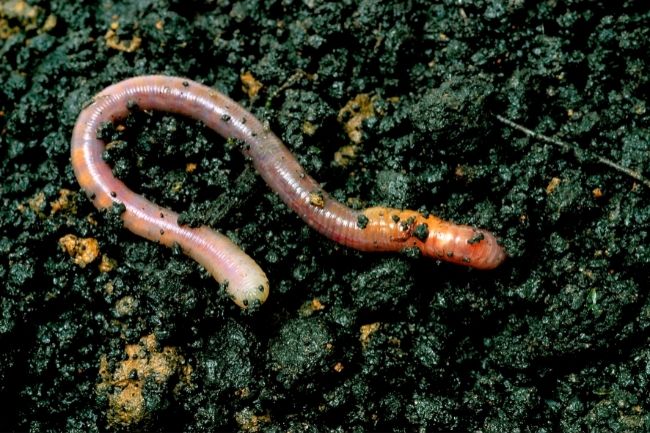Earthworms are often colloquially referred to as insects, however, they do not officially belong to this group. Instead, they are a type of annelid.
Insects have an external skeleton, a body composed of three sections and three sets of legs, all of which earthworms are missing.
Contents
What is an insect?

While many people use the term ‘insect’ rather loosely to refer to any small animal that crawls across the soil or flies through the air, technically not every creepy-crawly we see is an insect.
While ladybirds, bees and butterflies may all be insects, spiders, millipedes and slugs are not. Spiders with their eight legs sit within the Arachnids, millipedes, with their many legs are Diplopoda, and slugs, with no legs, are Mollusca.
Insects are a wide ranging group, containing an estimated 30 million species. These species are incredibly diverse, however, they have a number of features in common that consign them to their group.
| Characteristic | Earthworm | Insect |
|---|---|---|
| Classification | Earthworms belong to the phylum Annelida | Insects belong to the phylum Arthropoda |
| Body Structure | Elongated, cylindrical body with segmented sections | Three distinct body regions: head, thorax, and abdomen |
| Legs | Earthworms do not have legs | Insects typically have six legs |
| Exoskeleton | Earthworms lack an exoskeleton | Insects have an exoskeleton made of chitin |
| Antennae | Earthworms do not possess antennae | Insects often have antennae |
| Respiration | Earthworms respire through their skin | Insects have specialized respiratory systems |
| Metamorphosis | Earthworms do not undergo metamorphosis | Insects undergo metamorphosis |
Firstly, insects have an external skeleton, known as an exoskeleton. This is different from mammals, which have an internal skeleton. This external skeleton is made of chitin, the same material as our fingernails are made from. Due to the weight of this external structure, insects are limited to what size they can reach.
Next, insects have three pairs of legs, so six in total. This is one of the easiest ways to know that spiders are not insects, as they have eight legs. When some insect species are juveniles they may have what appears to be additional legs, however, these are often not true legs. Caterpillars, for example, have six true legs and a number of prolegs that disappear when they become adults.
As well as legs, insects have a set of antennae. These are important sensory organs, that help them to detect chemical signals as well as other things such as heat and humidity. As with legs, antennae may not be as obvious when in juveniles, with some species.
The final, and perhaps most important feature, is that insects’ bodies are divided into three sections; the head, thorax and abdomen.
While many other species may have one or two of these features, thus making it easy to confuse them with insects, they do not have all of them, meaning they aren’t technically an insect.
Also read: Do Ladybugs Have Antennae? (The Ways They Can Use Them)
Why are earthworms not insects?

There are around 2,700 species of earthworms. While they range in size and somewhat in colour, they are mostly very recognisable to most people who are familiar with them. Earthworms are relatively simplistic species, with a tube-like bodies.
Earthworms are a type of annelid, not an insect. This phylum includes other soft-bodied species such as leeches. Unlike insects, earthworms do not have an exoskeleton. Yet, they also don’t have an internal skeleton like mammals.
Instead, they have a hydrostatic skeleton. This is skeleton is created by the use of a body cavity known as the coelom. High-pressure liquid helps to support their bodies, and muscles surrounding the skeleton help the worms to move.
One of the most obvious differences between earthworms and insects is that earthworms do not have any legs.
| Misconception | Explanation |
|---|---|
| Earthworms are insects | Earthworms and insects belong to different phyla (Annelida and Arthropoda, respectively) and have distinct characteristics that set them apart. |
| Earthworms have legs | Unlike insects, earthworms do not possess legs. Their locomotion is facilitated by the contraction and expansion of their muscular body segments. |
| Earthworms have an exoskeleton | Earthworms have a hydrostatic skeleton composed of fluid-filled segments, while insects have an exoskeleton made of chitin for support and protection. |
| Earthworms undergo metamorphosis | Earthworms develop through direct development, whereas insects often undergo metamorphosis, transitioning through distinct life stages. |
n order to move, they have a number of hairs along their bodies known as setae. These help to hold the worm in place, while it relaxes its muscles, which allows it to stretch out and then contract its muscles to pull itself forwards.
Worms are also missing the set of sensory antennae. Instead, they have a number of sensors dotted across their bodies, largely below the skin. These include sensors to detect touch, light and chemical signals.
Worms also do not have the classical bodies separated into three segments. Instead, worms have many segments, which are composed of the classical rings we notice on the outside of the worm.
All these things mean that earthworms are not in fact insects, being within a category of their own.
Also read: Earthworms Closed Circulatory System Explained
Creepy-crawlies
While we may know that technically worms are not insects, most people will refer to them as insects. This is largely for simplicities sake. Sometimes this can be a negative categorisation, seeing all ‘insects’ as unpleasant creatures. However, more and more, we are opening up conversations about how beneficial ‘insect’ species are to our environment.
Earthworms in particular are worthy of praise, tilling our soil and processing plant matter and other waste to release nutrients and provide food for other creatures. This work is essential for both our natural environment and also for us humans by supporting farming, helping to produce our food.
Not bad for a wiggly little annelid.

